 |
|

|
 |
TABLE of CONTENTS
 |
Commissioner announces organizational realignment |
By TK Kramascz
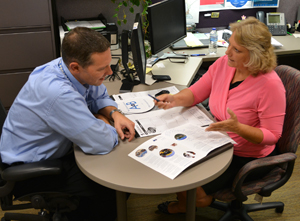
Chief of Staff Eric Davis discusses a project with Karla Rains, Customer Relations director. Photo by Rich Kemp |
Commissioner Charlie Zelle announced organizational changes Aug. 13 that realigns offices under MnDOT’s new executive management team—Chief Counsel Betsy Parker; Chief of Staff Eric Davis; Deputy Commissioner, Chief Operating Officer/Chief Financial Officer Tracy Hatch, and Deputy Commissioner and Chief Engineer Sue Mulvihill. The changes will take place between now and Oct. 1.
“The structure of the new team is intended to provide transparency and accountability in our financial and programming efforts, and to ensure that MnDOT continues to operate in its traditionally exemplary manner,” Zelle said in a memo to employees.
During much of July and August the executive team worked with staff from across the agency to determine where realignment could help make the agency “more effective,” he said. The latest organizational changes are:
Chief Counsel
The Office of Civil Rights now reports to the Chief Counsel. In addition, to improve the coordination of all agency legal services, the contract management and records management staff, who previously reported to the Office of Administration, will report to Chief Counsel.
Chief of Staff
The Chief of Staff, responsible for managing external stakeholder relationships, will ensure that messages to transportation partners, the Legislature and the public are consistent, accurate and reflect the agency’s mission. Employees in this area will coordinate statewide education and awareness campaigns that focus on the critical need for investment in transportation infrastructure. Functions reporting to the Chief of Staff are:
- Ombudsman
- Government Affairs
- Communications
- Customer Relations
- Strategic Initiatives
Deputy Commissioner, Chief Operating Officer and Chief Financial Officer
The functions reporting to this position are responsible for ensuring that MnDOT efficiently manages its resources. State Aid and the internal agency functions of Corporate Services are now under the direction of the Deputy Commissioner/COO/CFO. To help achieve agency goals for transparency and accountability, the agency’s audit function now reports to this position as well.
Other organizational changes in this area:
- The Office of Financial Management now reports to the Corporate Services Division.
- Emergency management staff, previously reporting to the Office of Maintenance in Operations, will be part of the CSD’s Office of Administration.
- Tech Connections is now under the direction of the Office of Administration.
- Training registration functions will move from Administration to Human Resources.
- The payroll and budgeting functions that resided within Administration’s Business Services section will move to Financial Management.
- Alternative finance functions of the former Policy Analysis, Research and Innovation Office will move to Financial Management.
Deputy Commissioner and Chief Engineer
The Deputy Commissioner/Chief Engineer directs the core transportation functions of Modal Planning and Program Management, Engineering Services and Operations divisions. Functions and employees of the former Policy, Safety and Strategic Initiatives Division have moved as follows:
- Employees working on Americans with Disabilities Act activities in the PARI Office will now work under Operations.
- PARI Library and Research Services staff and Transportation Economic Development program staff will report to the Office of Capital Programs and Performance Measurement.
- The Office of Traffic, Safety and Technology is now housed within Operations.
- The Office of Materials and Road Research is now housed within Engineering Services.
Other organizational changes in this area are intended to improve the agency’s financial accountability and to strengthen planning efforts by more closely aligning similiar functions. Those changes include:
- Enterprise Risk Management will now be under the direction of OCPPM.
- Reporting relationships for staff engaged in federal funds management and authorizations will move from OCPPM to the Office of Financial Management.
- Employees in the Office of Transportation Data and Analysis and the Office of Statewide Multimodal Planning will merge as a single section that will be housed within OCPPM.
For earlier organizational announcements, see Commissioner Zelle makes executive management changes (MnDOT Newsline, July 15, 2013). Look for the Sept. 4 edition of MnDOT Newsline for additional announcements.
|
 |
|

|
 |
TABLE of CONTENTS
 |
Project Update: Hwy 52 Lafayette Bridge provides challenges |
by Kevin Walker and Kent Barnard, Metro District Public Affairs
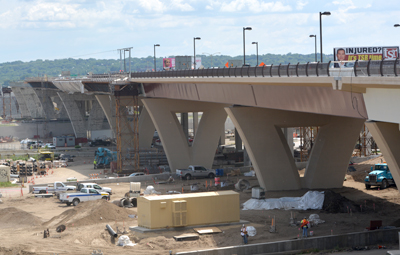
The north end of the new northbound Hwy 52 Lafayette Bridge was completed early so that work could begin on the southbound bridge. Photo by Rich Kemp |
Having reached nearly the end of its design life, one of the state’s busiest bridges is currently being replaced. The Hwy 52 Lafayette Bridge, located just east of downtown St. Paul, is one of the state’s most traveled bridges. It carries approximately 75,000 vehicles each day. The structure, which opened in 1968, is currently being replaced with two new bridges, one for northbound traffic and the other for southbound traffic. Construction of the two new bridges and surrounding roadways began Jan. 25, 2011 and is slated to be complete by late Sept. 2015.
At 3,000 feet, the bridges are among the longest bridges spanning the Mississippi River in the Twin Cities. The new northbound bridge is currently being built and will be finished at the end of 2013. Once complete, all traffic will be switched to the new northbound bridge as construction begins on the new southbound bridge.
Construction of the new bridges has presented a challenge to the bridge builders. With a busy port just upriver, construction activities have been carried out to maintain river traffic while observing height restrictions to allow air traffic from St. Paul’s Holman Field.
Additional work on the project includes re-decking the Hwy 52 Bridge over Plato Boulevard, improving connections to Interstate 94 and local roadways at the north end of the bridge, including adding signals at the new access from northbound Hwy 52 to East Seventh Street. A new ramp will be constructed in 2014 from eastbound I-94 to southbound Hwy 52 and a new pedestrian/bicycle trail over the Mississippi River on the east side of the northbound bridge will be constructed.
A crossover was built from the existing northbound Lafayette Bridge to the new northbound Hwy 52 Lafayette Bridge because construction activities on the new southbound bridge needed to occur in the 2013 construction season.
The crossover is narrow and has a tight turning radius near the north end of the northbound bridge, which makes it difficult for any vehicle or combination of vehicles more than 35 feet in length to maneuver the crossover safely. No vehicles or vehicle combinations of more than 35 feet in length, including charter buses and school buses, are allowed to use the Lafayette Bridge north of Plato Boulevard. The crossover will be in place until the spring of 2014.
When completed in late September 2015, the two new steel box girder bridges will each provide two through-lanes and an auxiliary lane in each direction for entering and exiting traffic. The project also includes replacement of the Hwy 52 bridges over I-94. The project limits stretch along Hwy 52 from East Seventh Street to just south of Plato Avenue. Lunda Construction Company of Black River Falls, Wisc., is the prime contractor for the $130 million project.
For more information about the Hwy 52 Lafayette Bridge project, visit mndot.gov/lafayettebridge/. |
 |
|

|
 |
TABLE of CONTENTS
 |
State Fair exhibit invites visitors to share their favorite “A to B” trips |
Visitors to MnDOT’s State Fair exhibit this year will be invited to share, on video, their responses to such questions as: “What’s your favorite A to B?” and “How did you get to the fair?” Staff will post the best answers each day to MnDOT’s Facebook page to start a dialogue about the importance of transportation in Minnesotans’ lives.
“We all have a stake in a strong transportation system,” said Commissioner Charlie Zelle. “Every trip we take from point A to point B, we use a road, a bridge, a rail line, a runway, a bike path or a waterway to connect us to our destinations."
The A to B theme at the fair is a sneak peek at what will be a larger education and outreach campaign this fall that MnDOT, transportation stakeholders and partners will engage in with the public. The campaign will highlight identified transportation needs during the next 20 years against a projected $50 billion funding gap.
“The bottom line is: there are many more worthy transportation needs than there is money to go around,” Zelle said.
Stop by MnDOT’s exhibit in the Education Building and share your own favorite A to B trip and pick up a state highway map.
Or visit the Kick Gas exhibit at the Eco Experience Building, where more MnDOT staff will be handing out state bicycle maps and encouraging people to bike or walk to some of their destinations.
For those who just love a parade—and who doesn’t?—check out Metro District crews as they drive a snowplow in the State Fair’s daily 2 p.m. parade on Friday, Aug. 23; Wednesday, Aug. 28; and Friday, Aug. 30.
|
Lisa Yang, Communications, records her A to B at the MnDOT State Fair Booth. |
|
 |
|

|
 |
TABLE of CONTENTS
 |
Updated paper, electronic editions of Minnesota state bicycle map now available |
By TK Kramascz
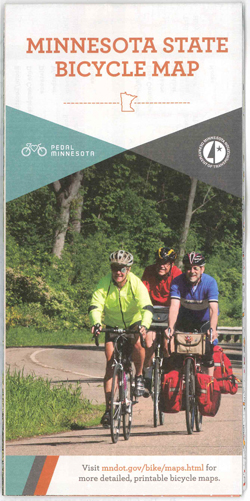
The Minnesota bycicle map is available in hard copy and on-line. |
For the first time since 2001 we’ve got an updated bike map to share.
The free map provides a clear view of bicycle trails and facilities all across the state and makes it easier for cyclists to plan long-distance bicycle trips.
The map will include information essential to making riding safe, fun and rewarding:
- Roadway details - shoulder width, pavement type and traffic volumes (low or high)
- State and regional trails, including the Mississippi River Trail
- State historic sites, parks, city index and other points of interest
The paper map is similar to the state highway map in physical appearance—size, design and layout—with the map itself appearing on the front, and resources, safety information and advertising appearing on the back.
The electronic version of the map, available at mndot.gov/bike/maps.html and compatible with smart phones, will feature more detailed routes than the paper version, with smaller and printable areas of the state and opportunities for public feedback. Cyclists also may request a paper version of the map on the website.
The online version of the map will be updated twice yearly.
Bicycling plays a big role in Minnesota's transportation system, and the state ranked as the fourth overall “Bicycle Friendly State” by the League of American Bicyclists in May 2013. States were evaluated based on legislation and enforcement, policies and programs, infrastructure and funding, education and encouragement, evaluation and planning.
Paper editions of the map are available at Central Office and at the Eco Experience Building during the Minnesota State Fair Aug. 22-Sept. 2. |
 |
|

|
 |
TABLE of CONTENTS
 |
Study addresses freight rail capacity questions in Southeast Minnesota |
|
By Greg Ruhland, Office of Freight & Commercial Vehicle Operations “Should we build a freight rail bypass around Rochester?”
It is a question that some citizens, anticipating a rise in freight rail traffic through the city, have grappled with for years. For a variety of reasons, their expectations haven’t panned out. Now the Southeastern Minnesota Freight Rail Capacity Study is shedding new light on the question.
The federally authorized and funded study was administered by the Office of Freight & Commercial Vehicle Operations and led by planner Peter Dahlberg, in cooperation with Olmsted County and the Federal Railroad Administration. Alternatives and feasibility findings were released in late July as an opportunity to explore issues of regional concern, like noise, livability, property values, economic development, safety and health, traffic flow, and groundwater and wetlands.
“What we found was, the rail line we have is sufficient to handle current freight traffic, plus moderate freight growth,” said Dahlberg. “With minor modifications, that line could even handle potential ZipRail passenger rail.”
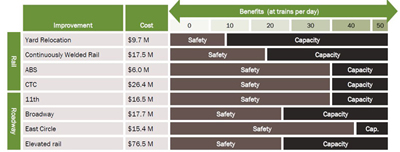
The chart above shows the recommended options for improvement of Rochester’s existing rail line. |
Left alone, it could accommodate as many as 12 trains a day, up from the current average of just three trains. Any growth beyond 12 freight trains, however, calls for other alternatives. That kind of growth seems unlikely.
Now on hold is an earlier line expansion plan that would have routed up to 40 mile-long coal trains each day from Wyoming’s Powder River Basin through Rochester. The move, signaling weaker demand for coal, also diminishes the likelihood of more expensive rail line alternatives and further alleviates regional concerns, saidTim Spencer, planning director.
While no single preferred alternative stood out in the study, it’s clear that the option to relocate or build a bypass line around Rochester would be far more expensive, Dahlberg said, than the costs to make its current line ready to handle more traffic.
Regardless of whether the Powder River Basin project gets picked up again, a number of smaller-scale measures can be done at any time, Dahlberg said, to improve freight capacity on the current line and even reduce the risk of a safety incident or hazardous freight disaster. These include yard relocations, power assisted track switching, a rail upgrade or even centralized traffic control.
“We knew we had a lot at stake in these final analyses,” Dahlberg said. “Rail capacity had to be sufficient, but we also needed acceptable traffic conditions at grade crossings and had to provide enough access for emergency response vehicles. All of this while balancing health, safety and environmental issues. The study is a thoughtful, planned response to the freight rail needs of a unique community.” |
 |
|

|
 |
TABLE of CONTENTS
 |
Donated vacation hours sought for Nancy Bennett |
Nancy Bennett, executive assistant for the Office of Government Affairs, has exhausted all her sick and vacation leave due to her husband’s serious illness and has been approved as a recipient under the state’s vacation donation program.

Nancy Bennett is pictured with her family from left: husband John, daughter Jackie and son Peter. Photo courtesy of Bennett family |
Two years ago, Bennett’s husband John was diagnosed with life threatening Chronic Traumatic Encephalopathy. His condition has progressed to a point that he needs 24-hour care.
Bennett has been with MnDOT since 2010. Previous to that she worked with the Department of Public Safety.
The state vacation donation program allows employees to donate up to 40 hours vacation per fiscal year to approved recipients.
To donate vacation leave:
- Go to Employee Self Service Website, click on “Other Payroll,” then “Leave Donations.”
- Select the magnifying glass next to “Reserve Bank” and choose Bennett’s name
- Enter the number of hours you wish to donate
- Click on the yellow “Save” box
Donation forms are also available from your Payroll or Human Resources office or at www.mmb.state.mn.us/doc/vacation/pe665.pdf.
|
 |
|

|
 |
TABLE of CONTENTS
 |
SEEDS program celebrates 20th year |
By TK Kramascz
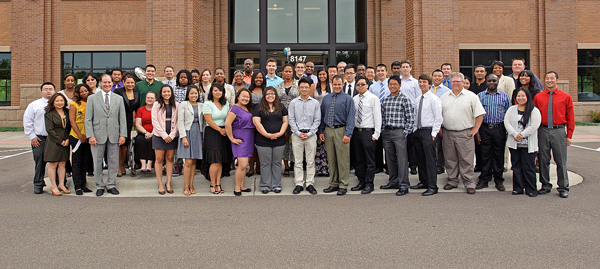
The Seeds Program’s alumni and students attended the 20th Anniversary ceremony and posed for a group photo with Commissioner Charlie Zelle Aug. 8. Photo by David Gonzalez |
The SEEDS Program celebrated its 20th anniversary on Aug. 8 with festivities, a luncheon, an awards program and remarks by Commissioner Charlie Zelle. Kevin Lindsay, Commissioner of the Department of Human Rights, gave the keynote address.
To date, more than 600 college students have completed the program, and each year more than 70 percent of Seeds graduates are hired and placed into permanent positions at MnDOT.
MnDOT launched the Seeds Program to help the workforce better reflect the communities it serves. Since then, MnDOT has placed many successful program graduates into permanent, full-time positions.
The Seeds Program provides paid, student worker positions to highly motivated minority or economically disadvantaged college students, students who are recently separated veterans, and students with disabilities.
In order to be considered for this program, candidates must meet the following requirements:
- Be a college level minority student, a student who is a recently separated veteran, an economically disadvantaged student or a student with a disability
- Be legally eligible to work in the United States
- Be a full-time student at a college, university, technical or trade school
- Be in pursuit of a major related to MnDOT’s needs
- Maintain a minimum GPA of 2.5 (3.0 for engineering majors)
- Have at least one year or more left before graduation
“Seeds has helped shape MnDOT’s workforce to reflect our communities, not just in Minnesota, but globally,” said Zelle. “Twenty years from now, just imagine how dynamic MnDOT will be as we continue to bring in new, fresh talent.”
|
 |
|

|
|

|
 |
TABLE of CONTENTS
 |
Records Management’s effort to update retention schedule well underway |
By TK Kramascz
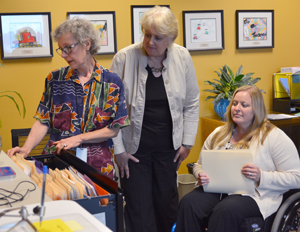
From left, Pam Newsome, Celine Carpenter and Heidi Bryand discuss the retaining of files for the commissioner’s office. Photo by TK Kramascz |
MnDOT’s Records Management program kicked off a major effort in May.
The goal is to reconstruct the current Retention Schedule into a more usable and functional format, laying the foundation for good management of all MnDOT records. This business effort was initiated in the Office of Administration and has involvement from all offices and districts.
Imerge Consulting, the Texas-based records management firm, has been contracted to help lead the effort and also will provide recommendations for applying best practices on retention of electronic records and make recommendations for a “self-audit” process that will measure and improve MnDOT’s records management program.
Initially, the project team is reviewing the existing retention schedule to identify items that are obsolete, that have changed, or that can be consolidated. For example:
- Metal Plates that were used for graphics typesetting years ago are still on the schedule.
- Specific forms that are no longer used are still on the schedule, although those activities still exist but are done differently.
- Individual documents that go into standard files, such as the Construction File, are in separate places on the schedule and can be consolidated.
The current schedule is an alphabetical list of about 1,800 documents. The new schedule will be organized by functions and activities into 300-500 “bigger buckets” or record series.
Additional deliverables will include a recommendation for implementing retention rules in electronic repositories; a recommendation for how to approach retention of database data; and a recommendation for a process to do ongoing measurement and evaluation of MnDOT's records program.
“We’re very excited about this project because the Retention and Disposal Schedule hasn’t been updated in its entirety since 1989,” said Pam Newsome, records manager. “A modern, functional retention schedule will be the foundation upon which we can implement better management of all of our business information.”
In the nearly completed “Discovery” phase, teams collected and reviewed information in various functional groups. Additional functional meetings, analysis and development will take place through October.
The documentation, review and revision process will take place between October 2013 and May 2014, the targeted project completion date.
Records management refers to retention and disposal of the information that documents the business conducted by MnDOT. Retention represents the period of time a record must be kept – and when it can and should be destroyed (or offered to the State Archives). Retention rules apply regardless of the medium – records can be electronic documents, digital images, database data, paper or other hard copy, or even physical artifacts.
The Control Environment component of the SafeGuarding MnDOT Program states as follows:
- Only information applicable to the agency’s responsibilities is collected and retained; extraneous information is disposed of appropriately.
- Up-to-date record retention schedules are maintained, and records are disposed of according to state law.
The first step toward doing a better job of that is to have an updated, more usable retention schedule. This project will provide that. The next step will be to use automation tools wherever possible so that MnDOT staff can apply retention rules not just to boxes of paper, but also to the agency's immense quantity of electronic records. |
 |
|

|
 |
TABLE of CONTENTS
 |
On the Job: Melissa Barnes puts interests in engineering, cycling to work |
By Mary McFarland Brooks

As a cyclist, bicycle and pedestrian safety is important to Melissa Barnes, pedestrian and bicycle safety engineer in the Office of Traffic, Safety and Technology. Photo by Brian Griffin |
Melissa Barnes, pedestrian and bicycle safety engineer in the Office of Traffic, Safety and Technology, is one of MnDOT’s newer employees, having started here in January 2013. She graduated from the University of Minnesota in Civil Engineering, where she had an interest in pavement engineering, and later as a traffic engineer, working at Kimley Horn & Associates, before coming to MnDOT.
“It’s hard to believe I’m here, as it’s really a dream job for me,” she said. “I am passionate about bicycle and pedestrian issues as a runner and cyclist, myself. If you’d told me when I was in school that I’d be here now, I definitely would’ve been surprised!”
How does your office help implement the agency’s multimodal strategic vision?
I work in the Office of Traffic, Safety and Technology, which is a part of the Toward Zero Death program. My focus is on strategic engineering to provide safe facilities for cyclists and pedestrians, which supports the OTST mission to reduce fatal and life changing crashes on Minnesota roadways and enhance the mobility of all users. The efforts of our office can lead to increased use of these facilities by more people, which can lead to health, economic and environmental benefits.
What is a typical day like for you?
I attend a lot of meetings! My day usually involves assisting one of the districts with a bike or pedestrian design issue, and if I’m lucky, I go out on a field visit. I’m involved with revamping our Share the Road campaign, rewriting the Traffic Engineering Manual, the statewide bicycle plan, the Safe Routes to School program and a couple of research projects. I’m always looking for new research regarding bike and pedestrian safety. Also, I get interesting phone calls. For example, I heard from a transcontinental walker who asked if he could walk on the interstates in Minnesota (he can’t). He said he has a limp, walks with a cane and plans to hike from Portland, Oregon to Portland, Maine next summer. He anticipates that it will take him about four months – that’s over 25 miles a day! These interactions are important as they remind me that what we do here is important to others.
What recent challenges have you faced?
I started in this position in January and then took some time off when our second son, Malcolm, was born this spring. I think the biggest challenge, being new to the organization and in a new position, is figuring out what everyone does and who everyone is. It’s a big organization and identifying contacts and appropriate policies is more than half the battle.
What is new in the world of cyclists and pedestrians?
Cycling is trending up, and bike and pedestrian fatalities are down! Everyone has an opinion about crosswalks.
Any funding challenges regarding what you do?
I’m actually figuring that out right now and I’m still not sure how it all works. I’m interested in identifying funding constraints and opportunities for each district in regard to different bicycle and pedestrian facility treatments.
What is the most rewarding part of your job?
I am working on things that matter; cyclists and pedestrians are vulnerable road users, so designing a safe environment for them is important. What I do can save lives, so obviously I feel it is important. Also, as a runner and cyclist, I am personally affected by changes in guidelines. Some of the roads on the state system are not conducive to cycling and walking. However, adding electronic devices, like pedestrian countdown timers and push buttons on signals, and introducing sharrows (arrows with bike symbol) to roadways can create a safer environment.
Do you or a co-worker have an interesting job to share with readers? Click here to send us your ideas, and we’ll contact you for more information.
Recent employee profiles:
|
 |
|

|
 |
TABLE of CONTENTS
 |
Bridge Office provides training for Leadership Development Program |
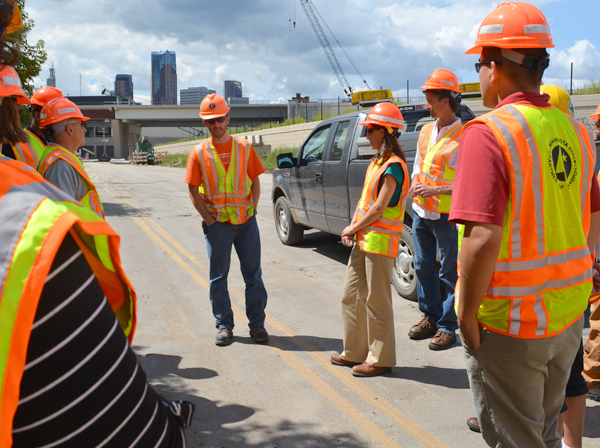
Nick Haltvick, mobility engineer to Lafayette Bridge project; Nancy Daubenberger, state bridge engineer; and Tom Styrbicki, construction and maintenance principle engineer; provided training during the Bridge 101 class Aug. 14. The classes were held at the Bridge Office and at the Hwy 52 Lafayette Bridge construction site. Photo by Rich Kemp |
|
 |
|
| |
|



